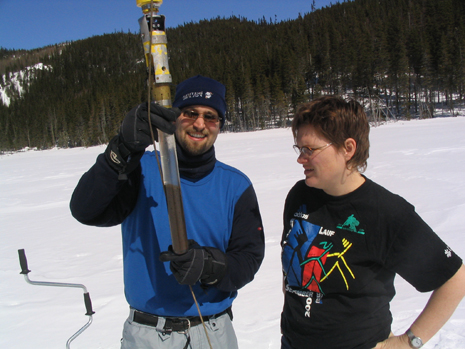Tiny Creatures Point to Possible Climate Change

Sonja Hausmann of the University of Arkansas and her colleague Guillaume St.-Onge of the University of Québec at Lac du Sommet with a McGlue corer in March of 2005. The researchers studied diatoms from the lake to determine how climate has changed in the past 9,500 years.
FAYETTEVILLE, Ark. – A University of Arkansas researcher and her colleagues studied core sediments from a shallow boreal lake and found that storm activity has increased substantially over the past 150 years. The rise in storm frequency appears to be linked to solar activity, but also may be linked to higher global temperatures resulting from increased amounts of greenhouse gases.
Sonja Hausmann and Falko Fye, professors of geosciences at the University of Arkansas; Isabelle Larocque-Tobler of the University of Bern, Switzerland; Pierre Richard of the University of Montréal, Canada; Reinhard Pienitz of Laval University, Québec City, Canada; and Guillaume St-Onge of the University of Québec at Rimouski, Canada, report their findings in The Holocene.
“We don’t really know if it is solar activity or if it is greenhouse gases because what we found correlates with both,” Hausmann said.
In the last 150 years, human activity has considerably increased the concentration of greenhouse gases in the atmosphere. Greenhouse gases trap heat in the lower atmosphere of Earth, raising the Earth’s temperature. Scientists have predicted that rising temperatures could lead to more frequent storms, and Hausmann’s evidence supports this.
However, Hausmann also compared the diatom-storm evidence to solar activity, which includes sunspots. Solar activity peaks and dips on 11-year and longer cycles. The diatom activity appears to fluctuate with the solar cycles, with stormy periods coinciding with high solar activity.
The researchers took core samples at Lac du Sommet, a shallow mountain lake in the Laurentian Mountains of eastern Canada. They were able to extend their climate reconstruction back 9,500 years.
Hausmann studies diatoms, unicellular algae with shells of silica, which remain in the sediments. Diatoms make excellent bioindicators, Hausmann said, because the diatom community composition changes with environmental changes in acidity, climate, nutrient availability and lake circulation.
By examining relationships between modern diatom communities and their environment, Hausmann and her colleagues can reconstruct various historic environmental changes quantitatively. In this case, they examined the residual effect of storms on the diatom communities in lake sediments. High winds cause the water column to circulate and mix the diatoms and nutrients in the water. In the absence of wind, diatoms settle at the lake bottom where they have less light. The researchers compared the diatom community structures to wind records from a nearby weather station established in 1965 and found that they matched well. They then examined the diatom community structures for the past 9,500 years.
The diatom evidence shows that storms have increased substantially over the last 150 years, Hausmann said.
She and her colleagues compared these findings to other tiny proxies: non-biting midges and pollen. Midge larvae live in the lake sediment and act as good indicators of temperature changes in a given environment. At Lac du Sommet, the midge evidence shows that temperature, while variable, has not recently increased in the same manner. Pollen evidence tells a similar story.
“The diatoms do not show a temperature effect. They show wind,” Hausmann said. “We are looking at climate change, not just temperature differences.”
Hausmann will return to Lac du Sommet during decreased periods of solar activity to see if diatom activity shows a similar decrease.
Contacts
Sonja Hausmann, assistant professor, geosciences
J. William Fulbright College of Arts and Sciences
479-575-6419,
shausman@uark.edu
Melissa Blouin, director of science and research communication
University Relations
479-575-3033,
blouin@uark.edu
Headlines
PetSmart CEO J.K. Symancyk to Speak at Walton College Commencement
J.K. Symancyk is an alumnus of the Sam M. Walton College of Business and serves on the Dean’s Executive Advisory Board.
Faulkner Center, Arkansas PBS Partner to Screen Documentary 'Gospel'
The Faulkner Performing Arts Center will host a screening of Gospel, a documentary exploring the origin of Black spirituality through sermon and song, in partnership with Arkansas PBS at 7:30 p.m. Thursday, May 2.
UAPD Officers Mills and Edwards Honored With New Roles
Veterans of the U of A Police Department, Matt Mills has been promoted to assistant chief, and Crandall Edwards has been promoted to administrative captain.
Community Design Center's Greenway Urbanism Project Wins LIV Hospitality Design Award
"Greenway Urbanism" is one of six urban strategies proposed under the Framework Plan for Cherokee Village, a project that received funding through an Our Town grant from the National Endowment for the Arts.
Spring Bike Drive Refurbishes Old Bikes for New Students
All donated bikes will be given to Pedal It Forward, a local nonprofit that will refurbish your bike and return it to the U of A campus to be gifted to a student in need. Hundreds of students have already benefited.




